We were in the Calais Jungle Refugee Camp when the police clashes started.
As part of our new push to cover hard news stories from a different angle, on Monday morning we headed to Calais from London to see if we could get access to the Calais Jungle Refugee Camp and get an insight into exactly what was going on down there. As soon as we got in, the clashes started. The following report and photos will detail the clashes, but more importantly, the dynamics between police, protesters, charity workers and the government.
The Situation:

Pic Credit: Author's Own
The French are forcefully dismantling the Calais Jungle refugee camp. They're doing this to make room for purpose-built container accommodation. However there's not enough container accommodation to go round. There are no communal areas in the container sector. Finally, immigrants must fully register and have an ID created to get access to the container accommodation. This is all free, however refugees are unwilling to register, on the grounds it'll prevent them from getting to the UK and to future jobs.
The Conundrum:
The French are in a tight spot. Simply wipe out the camp altogether and sure, the refugees will go, but where to? There'd also be utter outcry in the world media.
Alternately, build a fully functioning settlement with plenty of facilities and without a doubt far more refugees will come. This will lead to yet more tensions with border security, yet more UK immigration skirmishes, which will bring yet more media attention and yet more fuel to movements like Brexit. The French's approach has been to try and reduce the camp size whilst offering some accommodation. This is where we now are.
What Happened On The Ground
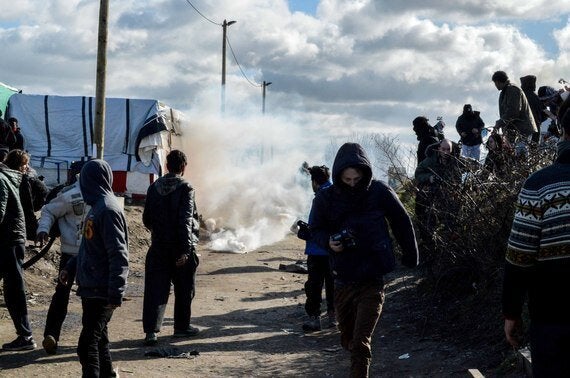
Pic Credit: Author's Own
The police moved in with bulldozers and started pulling down parts of the site. Refugees who resisted were hosed with cold water from a single riot truck, flanked by a team of riot police.
Those refugees that did resist did so by swarming as a group on the main road of the settlement and massing toward the police.
The police, in turn, fired tear gas. The police marched forward.
The refugees retreated up the road. The refugees regrouped. The police regrouped.
The entire cycle repeated on loop. This was painful to watch, but for reasons you may not have expected.
The Police:
Very, very, clearly did not want to be there. They looked actively miserable. There were maybe 30-40 police, and one truck only. There were no megaphones, no beatings. The police had shields and batons but appeared to be carrying no guns. Substantial advance warning was given at each stage. The truck revved for some time before advancing forward. The police would surge forward a few feet, causing the refugees to jump back perhaps a hundred feet themselves. The police would fire tear gas to the left and right of the crowd as warning, and wait patiently as charity volunteers stamped on them or used fire extinguishers.
The Refugees:
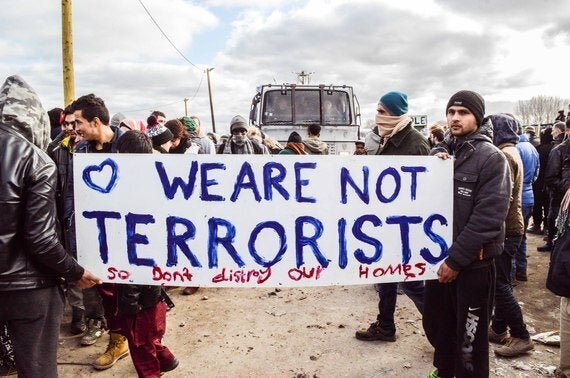
Pic Credit: Author's Own
Numbered perhaps an active 40 massed on the narrow road between the camp huts and tents, plus a further 60 or so standing around the road watching. The refugees were well behaved. There were shouts from various translators to remain calm. Perhaps 3 or 4 threw a single stone. They were loudly rounded on, by other refugees. The refugees eventually took to simply sitting down.
The Charity Volunteers:
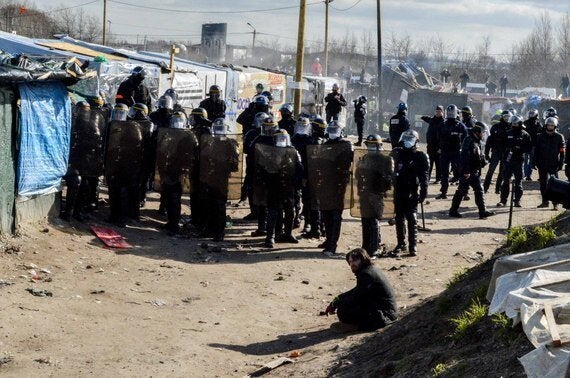
Pic Credit: Author's Own
Were, intentionally or unintentionally, the ringmasters of proceedings. It was this collection of a dozen or so white French and white British volunteers and a handful of translators that appealed for calm, ensured no one threw stones and explained to the refugees that the police would not charge or fire more tear gas, if the refugees remained calm. However, it was also the charity volunteers who co-erced refugees to grow bolder as the afternoon wore on, moving closer to the police wall, singing songs, carrying "We Are Not Terrorists" slogans.
The Overall Event:
Was more of a symbolic than physical situation. The charity volunteers proactively pulled journalists and photographers into a space between the police and refugees, which effectively helped slow proceedings as both sides were now even more cautious, with the exception of the volunteers themselves who became emboldened by the media.
The Camp Itself:
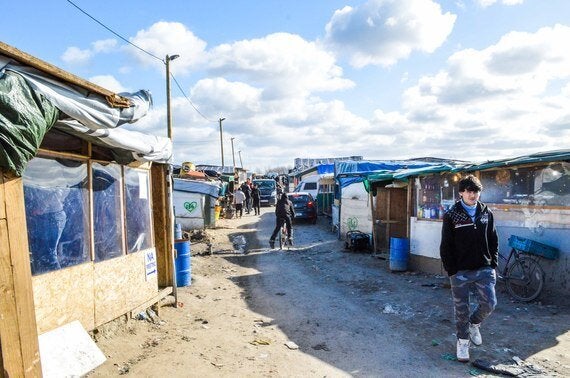
Pic Credit: Author's own
... Is grim. Volunteers have brought in portaloos and troughs with water tanks but these are clearly aged stock. The most sophisticated structures are medium-sized garden sheds. For the rest, it's tents and the odd mouldering caravan. The camp is also packed. Its got anywhere between 1,500-4,000 people. There's not a patch of ground that isn't now in use, save the two roads intersecting the camp, which are a mass of people, battered bikes and the odd aid van.
The Inhabitants:
Are freezing cold, and hungry. The thing about camping, is you are always outside. Most of them shuffle about to keep warm, and take shifts on jackets. It's also worth pointing out that this isn't one mass group: there were several nationalities there, all with completely different languages and camp areas. These aren't sharply divided - there is clearly camaraderie between groups, but there were no mobs. Just collections of two to five, all men (the women and children are in another area, forbidden to men) most of them aged around 14 to early twenties.
It's Clear Most Of Them Don't Really Know What's Going On:
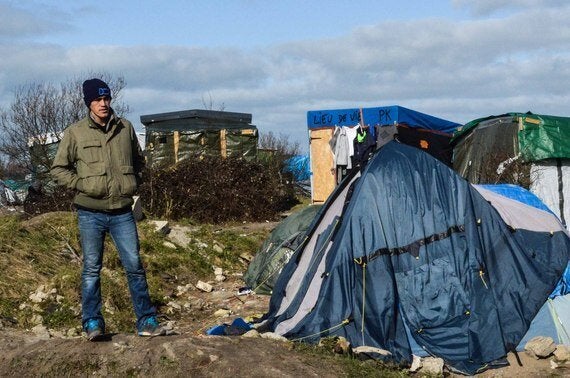
Pic Credit: Author's Own
They're listless. Probably because they're freezing and hungry. There was for the large part a lack of enthusiasm about the day's protesting. There's a distinct impression many of them don't really know why they had to flee home, don't know where they are now, and have no set plans going forward. It's worth pointing out there's no consistent electricity or internet access on site, and smartphones are very rare and mostly used for calling family. They may or may not even be aware of the publicity surrounding all of this. They seem grateful for the volunteers, but not exactly bonded to them, or even entirely sure why they're there either.
The Takeaway
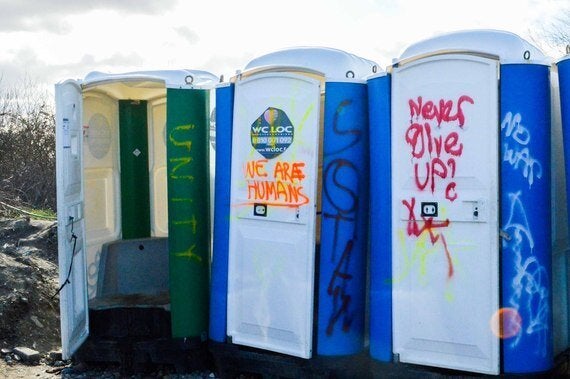
Pic Credit: Author's Own
This is not a problem that is going to go away. There are as much as four million of these displaced people across Europe and central Asia. The opinions on what to do are sharply divided in these times of political uncertainty of the EU's future. This report finds both political sides carry weight.
From the Right:
Correct. We simply do not have enough jobs to give our own semi-skilled workers, never mind thousands and thousands of even less skilled workers. If they come to the UK, they'll be placed into deprived areas and poor neighbourhoods with limited employment options which will drive up community tension. Meanwhile, the wealthy communities - those with voting clout - will flat refuse to host an influx into their own backyard, as it'll damage house prices.
From the Left:
Correct. We can't do nothing. These are women, children and above all desperate young men and the worst possible thing we can do is give in to media hysteria that they're all terrorists in waiting. They're not.
Where We Come In:
Millennials. It's time. It doesn't matter what sequence of events, which specific war or which autocratic regime caused this. It doesn't matter whether Islam really is or isn't a factor. This problem will not go away by itself, and this is the world we now inherit.
But we should take an odd strength from this. We are the most educated, most media savvy, most entrepreneurial, most open to living abroad and most socially conscious generation of all time. We are as a group mad as hell at what our governments have done over the last decade.
And now, we have a cause. We can find a way to fix this. How do we employ four million people? What online learning system, what new industry, what East European boom city do we need to build, to fix this, for good? The sooner we think as big as that, the sooner we realise several dozen people being hosed by water in a decrepit campsite wasn't some media-hyped epic clash of modern and medieval culture. It was just the splash to the face we needed to energise ourselves.
This article, with further pictures, first appeared in The Male Report
